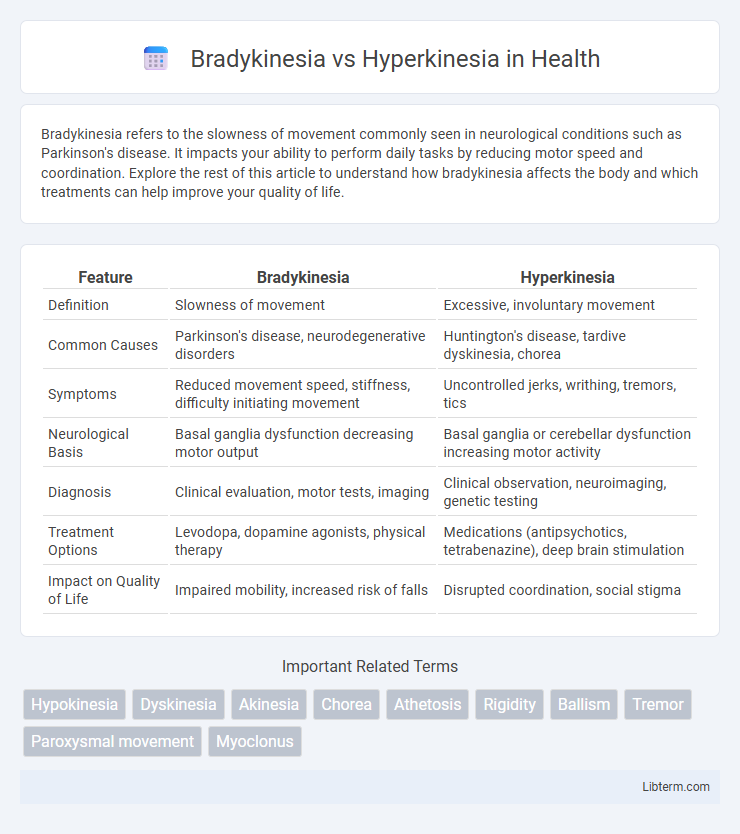Bradykinesia refers to the slowness of movement commonly seen in neurological conditions such as Parkinson's disease. It impacts your ability to perform daily tasks by reducing motor speed and coordination. Explore the rest of this article to understand how bradykinesia affects the body and which treatments can help improve your quality of life.
Table of Comparison
| Feature | Bradykinesia | Hyperkinesia |
|---|---|---|
| Definition | Slowness of movement | Excessive, involuntary movement |
| Common Causes | Parkinson's disease, neurodegenerative disorders | Huntington's disease, tardive dyskinesia, chorea |
| Symptoms | Reduced movement speed, stiffness, difficulty initiating movement | Uncontrolled jerks, writhing, tremors, tics |
| Neurological Basis | Basal ganglia dysfunction decreasing motor output | Basal ganglia or cerebellar dysfunction increasing motor activity |
| Diagnosis | Clinical evaluation, motor tests, imaging | Clinical observation, neuroimaging, genetic testing |
| Treatment Options | Levodopa, dopamine agonists, physical therapy | Medications (antipsychotics, tetrabenazine), deep brain stimulation |
| Impact on Quality of Life | Impaired mobility, increased risk of falls | Disrupted coordination, social stigma |
Understanding Bradykinesia: Definition and Features
Bradykinesia is characterized by the marked slowness of voluntary movement and is a core symptom of Parkinson's disease, often resulting from basal ganglia dysfunction. It manifests through decreased amplitude and speed of repetitive movements, leading to difficulties in initiating and sustaining motor tasks. This condition contrasts sharply with hyperkinesia, which involves excessive, involuntary movements, highlighting the spectrum of motor control disorders.
Hyperkinesia Explained: Types and Characteristics
Hyperkinesia refers to excessive, involuntary movements that can manifest as tremors, tics, chorea, or dystonia, often linked to neurological disorders such as Huntington's disease or Tourette syndrome. These abnormal movements result from dysregulation in the basal ganglia pathways affecting motor control, leading to unpredictable and excessive motor activity. Recognizing the specific type of hyperkinesia is critical for accurate diagnosis and targeted treatment strategies in movement disorder management.
Key Differences Between Bradykinesia and Hyperkinesia
Bradykinesia is characterized by slowness of movement and reduced amplitude of voluntary motion, commonly observed in Parkinson's disease. Hyperkinesia refers to excessive, involuntary movements such as tremors, chorea, or tics, often linked to conditions like Huntington's disease or dystonia. The key difference lies in motor activity level: bradykinesia results in decreased movement speed, while hyperkinesia involves abnormal increased movement intensity.
Underlying Causes of Bradykinesia
Bradykinesia primarily results from dysfunction in the basal ganglia, often linked to degeneration of dopaminergic neurons in the substantia nigra, as seen in Parkinson's disease. Other underlying causes include cerebrovascular lesions impacting motor pathways and certain medications that disrupt dopamine transmission. Understanding these mechanisms highlights the critical role of dopamine regulation in motor control and the pathophysiology of bradykinesia.
Triggers and Origins of Hyperkinesia
Hyperkinesia originates from dysfunctions in the basal ganglia, particularly involving imbalances in dopamine pathways that disrupt normal motor control. Triggers of hyperkinesia often include neurodegenerative diseases like Huntington's disease, certain medications such as antipsychotics, and metabolic disturbances affecting neural excitability. In contrast to the slowed movements characteristic of bradykinesia, hyperkinesia manifests as excessive, involuntary movements caused by excessive neural stimulation or circuit disinhibition.
Clinical Manifestations: Bradykinesia vs Hyperkinesia
Bradykinesia presents clinically as a marked slowness of voluntary movements, often accompanied by reduced amplitude and difficulty initiating tasks, commonly observed in Parkinson's disease. Hyperkinesia manifests through involuntary, excessive movements including chorea, tremors, and dystonia, frequently linked to conditions such as Huntington's disease and certain medication side effects. These contrasting motor symptoms highlight the fundamental neurophysiological differences affecting basal ganglia circuits.
Diagnostic Approaches for Movement Disorders
Bradykinesia is characterized by the slowness of movement and is commonly evaluated using the Unified Parkinson's Disease Rating Scale (UPDRS) during clinical examination, with emphasis on assessing finger tapping, hand movements, and gait. Hyperkinesia involves involuntary, excessive movements such as tremors, chorea, or dystonia, diagnosed through detailed neurological assessments and supported by video recording to capture fluctuating symptoms. Advanced diagnostic approaches include neuroimaging techniques like DaTscan to differentiate Parkinsonian syndromes and electrophysiological studies for abnormal muscle activity, enhancing accuracy in distinguishing bradykinesia from hyperkinesia in movement disorders.
Treatment Strategies: Managing Bradykinesia and Hyperkinesia
Treatment strategies for bradykinesia primarily involve dopaminergic medications such as levodopa and dopamine agonists to enhance motor function in conditions like Parkinson's disease. Hyperkinesia management often includes the use of anticholinergic drugs, benzodiazepines, or dopamine-depleting agents like tetrabenazine to suppress excessive involuntary movements seen in disorders such as Huntington's disease. Non-pharmacological interventions like physical therapy and deep brain stimulation may complement drug therapy to optimize motor control in both bradykinesia and hyperkinesia.
Impact on Daily Life and Quality of Life
Bradykinesia, characterized by slowness of movement, significantly impairs daily activities such as dressing, eating, and walking, leading to decreased independence and increased reliance on caregivers. Hyperkinesia, involving excessive involuntary movements like tremors or chorea, disrupts fine motor skills and coordination, causing challenges in tasks like writing or handling objects. Both conditions reduce quality of life by limiting mobility, increasing fatigue, and contributing to social withdrawal and emotional distress.
Recent Advances and Future Perspectives in Movement Disorder Research
Recent advances in movement disorder research have highlighted the distinct neural mechanisms underlying bradykinesia and hyperkinesia, with neuroimaging studies revealing differential patterns of basal ganglia dysfunction. Innovations in wearable sensor technology enable precise quantification of motor symptoms, facilitating early diagnosis and personalized treatment strategies. Future perspectives emphasize gene therapy and neuromodulation techniques, such as deep brain stimulation refinements, to target specific pathways implicated in these movement abnormalities.
Bradykinesia Infographic

 libterm.com
libterm.com